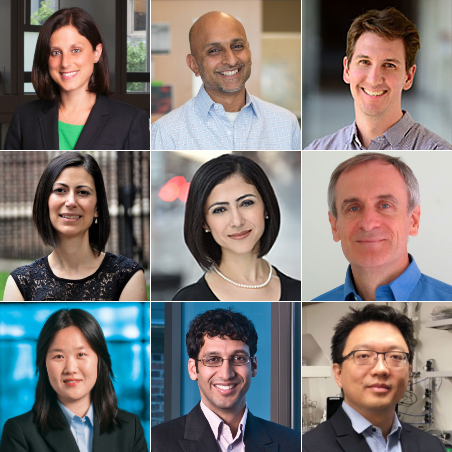Popular accounts of the human genome often depict it as a long string of DNA base pairs, but in reality the genome is separated into chromosomes that are tightly twisted and coiled into complex three-dimensional structures. These structures create a myriad of connections between sites on the genome that would be distant from one another if stretched out end-to-end. These “long range interactions” are not incidental — they regulate the activity of our genes during development and can cause disease when disrupted.

Now two teams of researchers at the Perelman School of Medicine at the University of Pennsylvania, each led by Jennifer E. Phillips-Cremins, associate professor and Dean’s Faculty Fellow in the Department of Bioengineering at the School of Engineering and Applied Science and of Genetics at the Perelman School of Medicine have been awarded grants totaling $9 million from the National Institutes of Health (NIH), as part of a major NIH Common Fund initiative to understand such 3D-genomic interactions.
The initiative, known as the 4D Nucleome Program, broadly aims to map higher-order genome structures across space and time, as well as to understand how the twists and loops of the DNA sequence govern genome function and cellular phenotype in health and disease.
Linking Genome Miswiring to Human Disease
Under one five-year grant, for a total of $3.1 million, Phillips-Cremins will work with four other principal investigators, all of Penn Medicine: Rajan Jain an assistant professor of Cardiovascular Research and Cell & Developmental Biology, Eric Joyce, an assistant professor of Genetics, Melike Lakadamyali, an associate professor of Physiology, and Golnaz Vahedi, an assistant professor of Genetics. The team will apply 3D architecture mapping and genome engineering tools to better understand a rare and often fatal inherited disorder called Friedrich’s Ataxia.
Friedrich’s Ataxia usually manifests in late childhood with difficulties in walking, talking, or controlling eye movements. Neurological signs and symptoms accumulate over time, with patients often requiring a wheelchair within a decade or two. The disorder also features progressive damage to the heart, which — depending on the severity of the condition — can cause an early death.
There is as yet no cure or disease-modifying treatment, although the ultimate cause of Friedrich’s Ataxia is well understood: It arises when both of the patient’s copies of a gene called FXN contain an abnormally high, or “expanded,” number of short DNA sequences called tandem repeats. The more repeats, the worse the disease. A major barrier in finding therapies for the disease is that researchers haven’t been able to determine how this abnormality within the gene leads to such a complex and devastating disorder.
The group will use single-cell techniques to investigate the possibility that the 3D folding patterns of the DNA are functionally linked to the severity of instability of a specific short tandem repeat sequence in FXN, leading to severe pathologic gene silence. Discoveries from the research funded by this grant will shed light on the causes—and possibly inspire new treatments—not only for Friedrich’s Ataxia but also of other repeat expansion disorders.
Unraveling Genomic Architecture’s Fourth Dimension
A second five-year grant, with total funding of $5.9 million over five years, will see Phillips-Cremins joined by four other principal investigators at Penn: Gerd Blobel, a professor of Pediatrics and Eric Joyce, an assistant professor of Genetics, both of Penn Medicine, as well as Bomyi Lim, an assistant professor of Chemical and Biomolecular Engineering and Arjun Raj, professor of Bioengineering, both of Penn Engineering. Raj and Lim have secondary appointments are in Penn Medicine’s departments of Genetics and Cell and Developmental Biology, respectively, and Stanley Qi of Stanford University will also serve as a principle investigator.
This project will examine the “fourth dimension” of genomic architecture, namely, how it changes over time. The team’s studies will employ model systems ranging from induced pluripotent stem cell reprogramming, to erythroid differentiation, and neural circuit activation.
The team plans to develop new microscopy and sequencing methods to capture a series of what are effectively snapshots of the 3D genome as it changes its conformations. These changes, which form and un-form DNA loops, occur across a broad range of time scales from seconds to minutes to weeks. The investigators will also explore the genome’s structure-function relationship by developing new strategies to engineer loops on demand and across time scales, then engineering and imaging loops in single cells to quantify their dynamics in more realistic contexts.
New Spatial Epigenetics Center of Excellence at Penn
The two new grants will catalyze the formation of the Spatial Epigenetics Center of Excellence (SECOE) at Penn, formally establishing a hub of internationally renowned investigators focused on spatial approaches for studying epigenetic and genetic regulation across a wide range of organ and disease systems, as well as a time scales ranging from milliseconds to decades. Led by Phillips-Cremins, the members of the SECOE will pioneer new imaging, genome engineering, sequencing and computational technologies to understand human development and disease through the lens of spatial connections.
“Over the last decade, methods advancing our ability to query DNA’s higher-order folding patterns in the 3D nucleus have provided tremendous insight into how the genetic material works through long-range mechanisms to control genome function. Our center aims to establish a technology hub in Philadelphia to broaden the impact and application of spatial approaches to solve a wide range of fundamental biological questions.” says Phillips-Cremins.
